Abstract
This paper describes an experimental investigation of the behaviour of self-consolidating concrete (SCC) produced under conditions of hot weather studied in the context of manufacturing control specimens. Two different designs were tested, incorporating either OPC or slag cement. The spread, determined during the slump–flow test, was kept constant whatever the initial temperature (20 or 50 °C), either by additions of water or by superplasticizer over dosage at the end of mixing. L-box and sieve stability tests were also employed to assess the self-consolidating ability. Specimens were cured under the conditions specified in the standards for manufacturing control (20 °C, 100 % RH). Compressive strength, bulk modulus of elasticity, porosity, water absorption, migration of chloride ion and gas permeability were quantified. Results on SCC mixed at high temperature (50 °C) relative to results for the reference mixes (20 °C) showed that mechanical and physical properties were not altered or improved by the increased mix temperature.


Similar content being viewed by others
References
American Concrete Institute (2010) Guide to hot weather concreting, 305R-10, reported by ACI Committee 305, p 23
Diederich P, Mouret M, Ponchon F (2013) Simple tools for achieving self-compacting ability of concrete according to the nature of the limestone filler. CBM 48:840–852
EFNARC (2002) Specification and guidelines for self-compacting concrete. European association for producers and applicators of specialist building products. EFNARC, UK
Kollek JJ (1989) The determination of the permeability of concrete to oxygen by the Cembureau method—a recommendation. M&S 22:225–230
Le VA, Cassagnabère F, Mouret M (2013) Influence of mixing and curing temperatures on the properties of fresh and hardened SCC in hot weather conditions. In: 7th SCC Congress, Paris
Mouret M, Bascoul A, Escadeillas G (2003) Strength impairment of concrete mixed in hot weather: relation to porosity of bulk fresh concrete paste and maturity. MCR 55(3):215–223
Persson B (2001) A comparison between mechanical properties of self-compacting concrete and the corresponding properties of normal concrete. CCR 31(2):193–198
Shah A, Khan S, Khan R, Jan U (2013) Effect of high range water reducers on the properties and strength characteristics of fresh and hardened concrete. IJSTC 37C+, pp 513–517
Torrenti JM, Dantec P, Boulay C, Semblat JF (1999) Draft protocol for the determination of the longitudinal E modulus of concrete. Bull Lab Ponts Chaussées 4263:79–81 (in French)
Author information
Authors and Affiliations
Corresponding author
Rights and permissions
About this article
Cite this article
Cassagnabère, F., Mouret, M. & LE, V.A. Properties of SCC Mixed in Hot Weather Conditions: Workability, Mechanical and Physical Aspects. Iran J Sci Technol Trans Civ Eng 40, 251–255 (2016). https://doi.org/10.1007/s40996-016-0020-5
Received:
Accepted:
Published:
Issue Date:
DOI: https://doi.org/10.1007/s40996-016-0020-5




